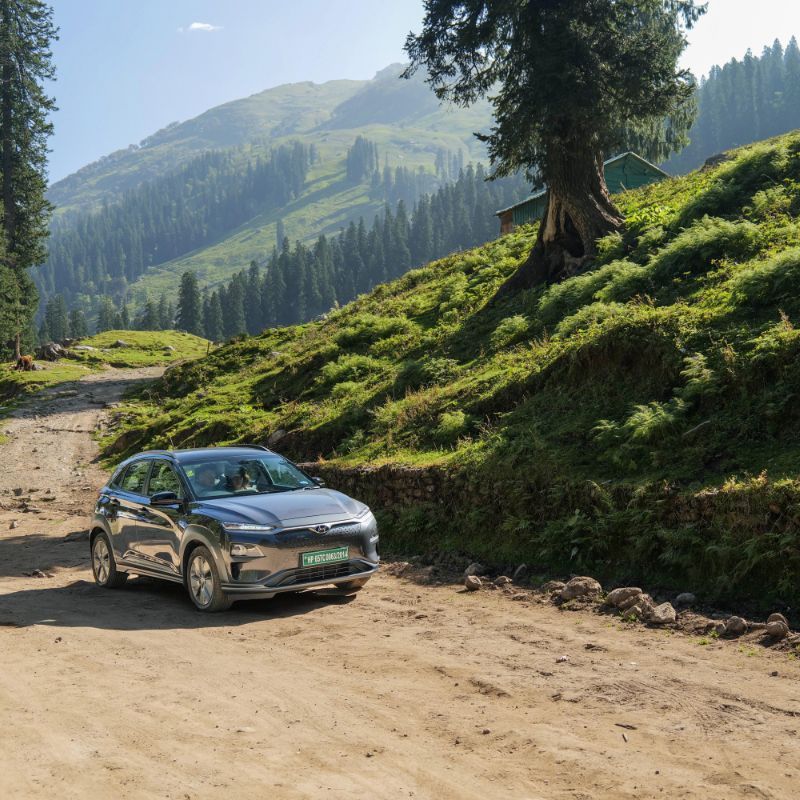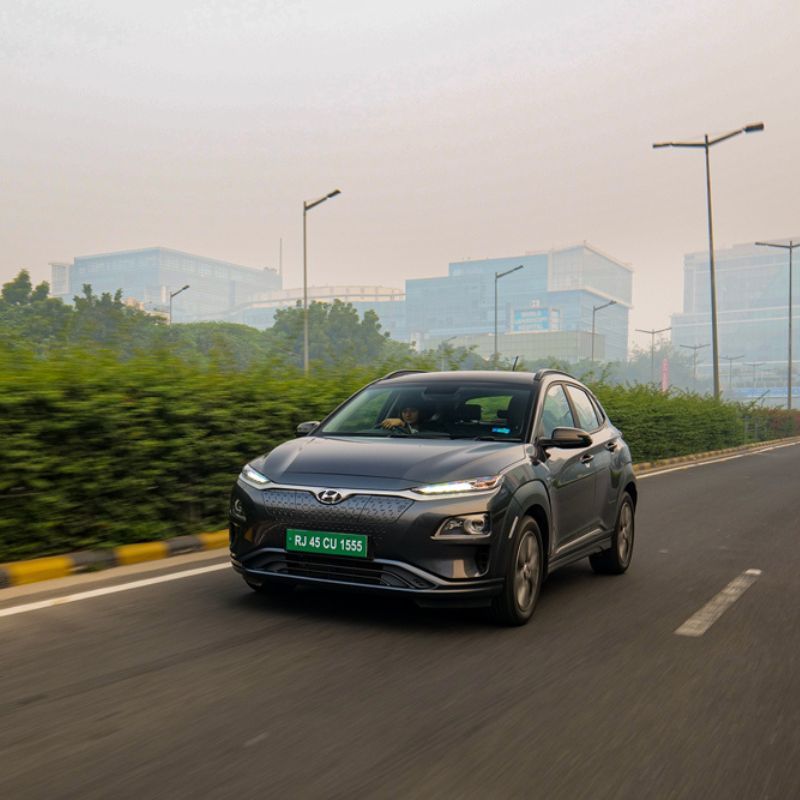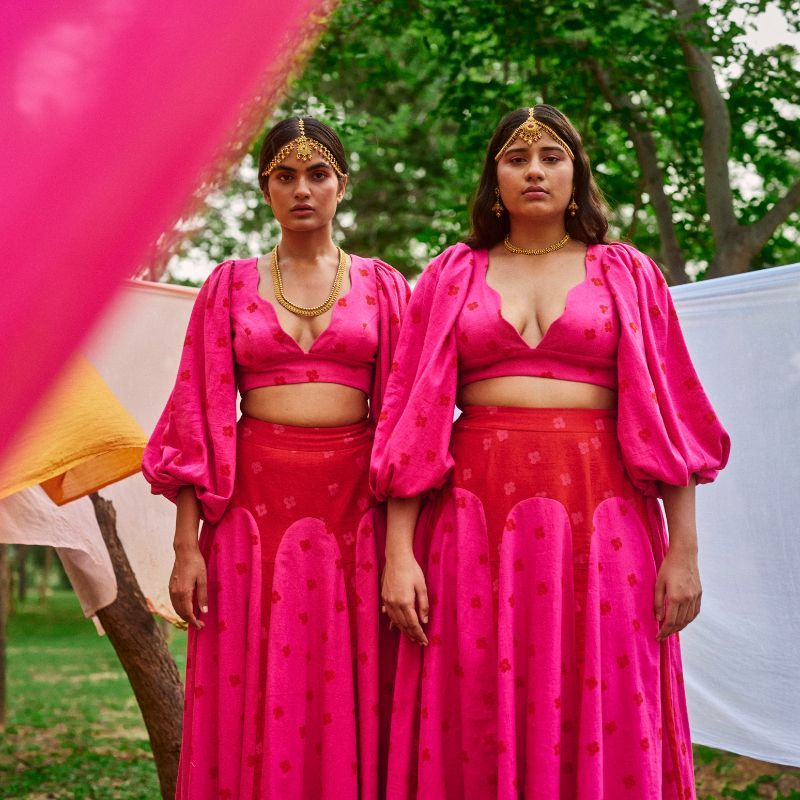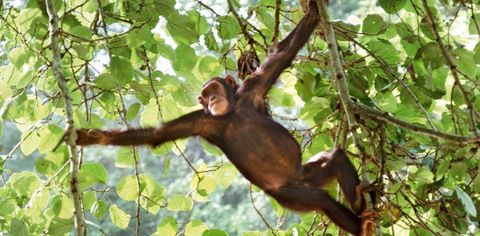
In recent decades, a community of 29 chimpanzees in an isolated Ugandan rainforest has become cut off from the rest of its species. A traveller meets these remarkable creatures and the conservationists working to help them survive. Text by Gina Decaprio Vercesi; photographs by Michael Turek
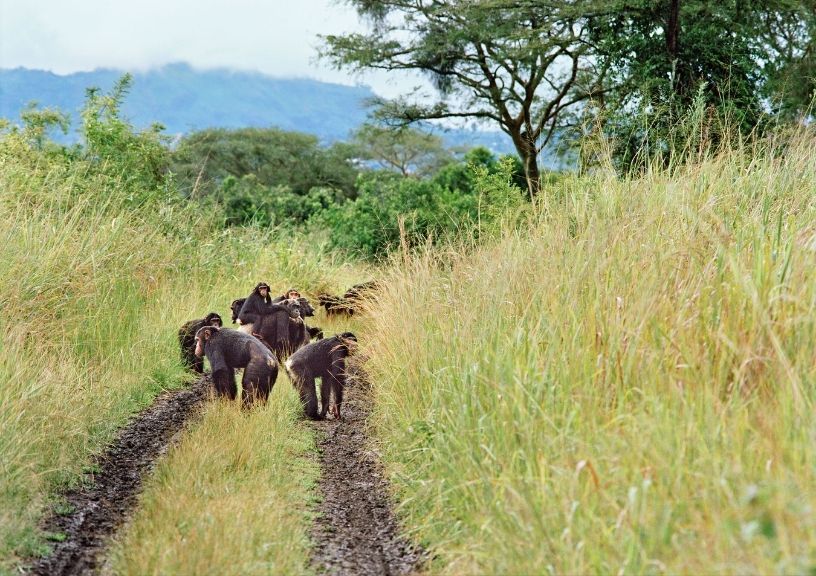
I heard the chimps before I saw them—one lone call followed by a riotous chorus of pants, hoots, howls, and screams until the entire forest reverberated with a primal din.
“They are disciplining someone,” explained Ruth Imalingat, the Uganda Wildlife Authority ranger leading my tracking excursion. “I suspect Mweya is giving a beating.” As the cacophony rose again, Imalingat turned towards the sound. “They are moving,” she said, looking back at me. Chimpanzees travel on foot when searching for food, but spend most of their time far above the ground in the thick vegetation of the rainforest’s canopy, where they’re more difficult to observe.
I fell into step as she trampled through the dense brush, rifle slung over her shoulder. The gun was a precaution. If we were to meet an elephant on its way to the river, she’d fire a shot into the air to scare it away.
My heart pounded as another round of hoots pierced the air. I searched the treetops for the howling primates, trying not to trip as we bushwhacked through the tangle of shrubs and saplings that sprung from the forest floor. I could just make out the camouflage print of Imalingat’s uniform through a ropy curtain of saba florida vines and scrambled to catch up, wiry branches snapping against my face. Just then, the caterwauling reached the third crescendo. This wasn’t a PBS documentary—we were in the midst of a bona fide chimpanzee fracas.
I was in a deep Kyambura Gorge, a sunken rainforest carved into the vast savannah of southwestern Uganda’s Queen Elizabeth National Park. Home to an isolated family of 29 chimpanzees, the gorge sits within the Albertine Rift, one of the poorest, most densely populated rural areas on the African continent. The people living near Kyambura Gorge use firewood to fuel their stoves. They rely on subsistence agriculture and need fertile land to grow their crops. And they harvest trees from the gorge for the small boost the sale of timber gives their household income, which hovers around INR 11,820 per year. Unfortunately, these actions come at a cost to the environment. Over the past two decades, deforestation and community encroachment have trapped Kyambura’s endangered apes in their jungle habitat. Females have been unable to visit neighbouring chimp communities to mate, and human-chimpanzee skirmishes have increased.

But in 2019, East Africa outfitter Volcanoes Safaris secured a three-kilometre-long swathe of land to create a buffer zone between the gorge and the adjacent villages. The buffer is just one part of the Kyambura Gorge Eco-tourism Project, which aims to protect the chimpanzees and their fragile ecosystem by developing alternatives to the locals’ reliance on the gorge’s natural resources. I went to Uganda to learn about the project and see its various initiatives in action. I also went to see the chimps. And though I’d heard that they often remain elusive, the hullabaloo echoing throughout the jungle suggested that luck was on my side.
The vocalisations intensified as we entered a clearing. High overhead, the canopy shook as the apes swung from tree to tree, their shapes silhouetted against the sky. “Do you see the alpha climbing?” Imalingat asked, pointing as one of the chimps clambered hand-over-hand up a tall ironwood tree and disappeared into its fronds. Mweya, she’d explained earlier, was attempting to usurp authority from Kihango, the family’s alpha male. Young males like Mweya often work to dominate other young males, as well as females, in their attempts to climb the ranks. The shrieks of the offender, likely a female, grew louder and more desperate as the scolding continued. The noise was heartbreaking, yet Imalingat assured me that these displays often sound much worse than they actually are. Soon, the cries of Mweya’s victim waned and Imalingat interpreted their meaning. “‘Sorry,’” she translated. “She’s saying, ‘I’m sorry.’”
Contrary to the almost meditative experience of observing mountain gorillas, one of Uganda’s primary tourist draws, a chimpanzee encounter feels like watching a bunch of sugar-jacked five-year-olds in a trampoline park. My rendezvous with the motley simian crew was the last thrilling act of a 10-day journey through East Africa with Volcanoes Safaris. Founded in 1997, the company pioneered great-ape tourism in the region and now operates four luxurious eco-lodges, three in Uganda and one in Rwanda. Uganda-born owner Praveen Moman is committed to reducing human-wildlife conflict in the area, and finding solutions to those conflicts has been central to his vision from the outset. “The local communities have no intrinsic interest in the wildlife,” Moman had told me over lunch in New York City a few months before my trip. “They need the land for cultivation. They need to feed their kids. We’ve been looking at all the issues around humans and wildlife living together and trying to create a win-win situation. Wilderness has to produce an economic return.”
As part of that mission, in 2009 Moman created the Volcanoes Safaris Partnership Trust (VSPT), a non-profit designed to enrich the livelihoods of people living near the lodges and encourage them to feel more invested in conservation tourism. He is not alone in his efforts. The creation of a strong, wildlife-focussed economy as a way to protect vulnerable habitats is a strategy that has worked well in many places where humans and animals cohabit—and it’s one that has slowly gained traction in the villages surrounding Kyambura Gorge.

I spent days leading up to Kyambura at the other three Volcanoes lodges—Virunga, Mount Gahinga, and Bwindi—each of which has its own unique cultural and outdoor adventures. I hiked to see a frisky troop of golden monkeys in Mgahinga Gorilla National Park and had an epic encounter with gorillas in the misty jungles of Bwindi Impenetrable Forest. On the drive to Kyambura Gorge through Queen Elizabeth National Park, long-time Volcanoes Safaris guide Francis Kiwanuka identified spiral-horned Ugandan kob, mud-caked Cape buffalo, and baby baboons with pink faces and pointy ears that reminded me of those plastic trolls from the 1960s. I arrived at Kyambura Gorge Lodge hot, dusty, and full of wonder.
The property sits within a vastly different ecosystem to that of its counterparts in the south. There, the jungles of the Virunga massif—a stunning volcanic range that sprawls across the borders of Rwanda, Uganda, and the Democratic Republic of the Congo—create a dramatic backdrop. But in this spot, 24 kilometres from the equator, the golden savannah stretches in every direction, punctuated only by lacy acacia trees and the occasional solitary elephant. To the north, the jagged pinnacles of the Rwenzori range, known as the Mountains of the Moon, etch the horizon.
Built in 2011, Kyambura Gorge Lodge is the newest of Volcanoes Safaris’ properties. A 2019 renovation introduced four deluxe bandas overlooking the gorge. After my butler, Beatrice Nasingura, had shown me around mine and relieved me of my dirty boots, I drenched myself in the outdoor shower. Sundowners on the terrace, a dinner of spicy watermelon soup and vegetable samosas followed by coconut ice cream, and a mosquito-netted bed warmed by a hot-water bottle meant sleep came easily.
I didn’t stir until Nasingura returned just before sunrise with a pot of hot coffee brewed with beans from the nearby Kyambura Women’s Coffee Cooperative. Another venture within the Kyambura Gorge Eco-tourism Project, the co-op employs women from the local village, several of whom are widowed, HIV-positive, or both. The women pick, sort, wash, dry, roast, and hand-grind coffee grown on 100 acres of VSPT land. They also run the on-site Kyambura Community Café, which serves fresh coffee and wood-fired pizzas while training disadvantaged youth from neighbouring villages in hospitality. Nasingura told me that she started out as a cafe trainee. Now she’s one of the lodge’s best-loved butlers.
The early wake-up gave me just enough time for breakfast before setting out with Kiwanuka for the short ride to Fig Tree Camp, the gathering point for chimp tracking, where Imalingat was waiting. I signed the guest log and climbed the stairs to a wooden observation deck. Beneath me lay the wide savannah, cleft by the lush Kyambura Gorge. Unlike my treks in the Virungas to see golden monkeys and mountain gorillas, which involved trackers going ahead of the group and signalling back to guides once the primates were located, finding these chimpanzees required a bit more effort.

“Today, we shall go as the trackers,” Imalingat said, leading me down a steep trail accompanied by the thunderous snorting of hippos. “We shall have to listen for the calls, check out the trees where they are eating.” As we wound our way along the Kyambura River, a resonant thumping echoed through the forest—our first clue to the chimps’ location. “They are hitting the trees,” Imalingat explained, pointing to a huge Pterygota with winged buttress roots that came up to my neck. “That means they’re travelling. The drumming is a communication system for chimpanzees.”
Chimp droppings and a few isolated cries led us to the other side of the river, where we found the chimps having breakfast. Tucked among leafy limbs heavy with figs, the apes were serene. They ate and dozed, mated and groomed, while the babies swung from branch to branch in a perfect facsimile of kids playing on monkey bars.
“Let us take our time,” Imalingat suggested. “They are busy eating. We shall wait and see what happens.”
I craned my neck and fixed my camera lens on a chimp gazing skyward while reclining on a branch. Birdsong filled the forest, interrupted periodically by hoots from the trees and the hippos’ trumpet-like exhalations. Figs hit the ground around my feet, dislodged by the chimps’ movements. “These guys will not stick long here,” Imalingat observed. “They look to be satisfied already.”
As if on cue, a large chimpanzee climbed down from the canopy and settled into the crook of a low-hanging branch across from where we stood. Although the chimp regarded us with an attitude that bordered on blasé, I found that I was holding my breath. “He’s quite a friendly boy,” Imalingat told me. “His name is Mweya.” It was Mweya who would stir the chimps into their wild rumpus during our second visit to the gorge later that afternoon. But now the young male, wearing a remarkably human expression, seemed almost contemplative.
Back at the lodge I met Dr. Peter Apell, the field programmes manager for the Jane Goodall Institute (JGI) in Uganda. Apell had last visited Kyambura a decade earlier; he returned to see the evolution and impact of the Kyambura Gorge Eco-tourism Project first-hand. Over lunch, he explained some of the ways his organisation could support Volcanoes’ efforts to safeguard the gorge and the chimps— especially since those efforts so closely parallel the JGI’s commitment to nurturing a peaceful coexistence between humans and chimpanzees. “The most viable option is to look at the aspects of the community’s livelihood that are linked with the forest and then find alternatives that are of higher value,” Apell told me.

Honey production is one of those alternatives, and Kyambura Lodge has worked with Kampala- based Malaika Honey to train local farmers in commercial beekeeping since 2012. The hives create a kind offence that protects farmers ’land from crop-raiding elephants, while honey sales put money into their pockets. The initiative is an illustration of the type of win-win scenario Moman hopes will shift the region’s paradigm in a more sustainable direction, especially since mining the forest for timber and farmland further diminishes the chimps’ habitat. It also makes it virtually impossible for females to leave the gorge to find genetically diverse mates—which is crucial to the Kyambura chimps’ survival.
On our game drive through Queen Elizabeth National Park the previous day, Kiwanuka had described some of the dangers the savannah harbours for female chimpanzees attempting to travel between forest fragments in search of other chimp communities. The park’s tree-climbing lions often lie in wait on the branches of sycamores, while leopards skulk in the tall grasses. Still, the instinct to procreate is a powerful motivator, sometimes prompting breeding females to leave the forest’s shelter despite the risks.
In the spring of 2019, an immigrant female appeared among the Kyambura chimps, the first visitor in many years. Imalingat and her colleagues don’t know where she came from, but they speculate that the community’s robust selection of virile young males makes the gorge an attractive mating ground. Her arrival supports some researchers’ theory that, in addition to the buffer zone, one of the chimps’ best hopes for survival is the creation of a protected corridor between Kyambura Gorge and the nearby Maramagambo Forest. The idea is ambitious—it could take 30 years to secure safe passage—but Volcanoes Safaris, in partnership with the JGI, remains open to pursuing it.
The next morning, my last in Uganda, I rose early to hike through the new buffer zone with Apell and a young naturalist named Saidi Kakuru. An accomplished student before he was forced to drop out of school when he lost both parents to AIDS, Kakuru got his start with Volcanoes Safaris at the Kyambura Community Café, like Nasingura. Each morning Kakuru would report to work early so that he could spend time learning about the birds that inhabit the Kyambura Wetland, a former illegal brickworks that has been restored to its natural state. In 2018, he became an official guide at the lodge, leading guests on short treks in the buffer and the wetlands.
Toward the end of our walk, we were given seedlings to plant as part of a reforestation project in the buffer zone. I watched as Apell dropped a tiny pigeonwood plant into a hole and tamped soil around its roots. “The task ahead is very, very tough,” he said, brushing the dirt from his hands and gazing at the surrounding landscape. “But as Dr Goodall says, ‘If we understand, then we will care, and if we care, then we will make a difference.’ ” I thought back to the chimpanzees’ ruckus the previous day—anger fading into apology and then cooperation again. Though their future was fragile, I felt certain that the chimps, and their supporters, would find a way forward.
Plan a Chimp Safari in Uganda
Emirates flies from Delhi and Mumbai to Uganda’s Entebee International Airport via Dubai. From Entebbe, it’s a short flight via Aerolink Uganda to Mweya Airport, where a guide will meet you and drive you to Kyambura Gorge Lodge.
The Experience
Volcanoes Safaris (from INR 2,43,738 per person, all-inclusive) can arrange a four-day itinerary at Kyambura Gorge Lodge that includes an expedition to track chimpanzees, game drives to see tree-climbing lions, and visits to local community projects. The safari can be combined with stays at other lodges in the Volcanoes Safaris family: Mount Gahinga Lodge and Bwindi Lodge, also in Uganda, and Rwanda’s Virunga Lodge, all of which offer mountain-gorilla tracking.
Editor’s Note: Keeping the current situation of the pandemic in mind, T+L India recommends every reader to stay safe, and take all government-regulated precautions in case travel at this time is absolutely necessary. Please follow our stories on COVID-19 for all the latest travel guidelines.
Related: Here’s How You Can Adopt An Animal & Donate To Uganda’s Zoos During The Pandemic


